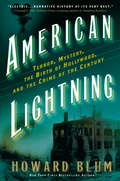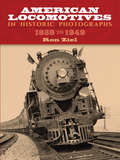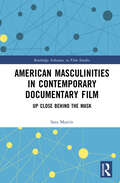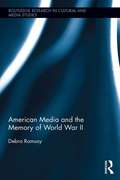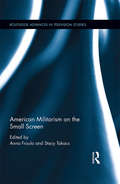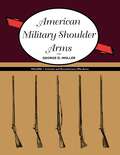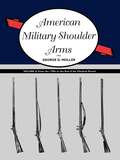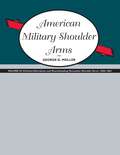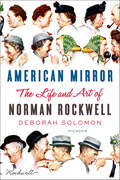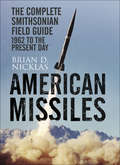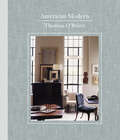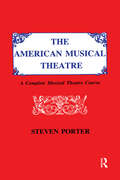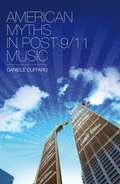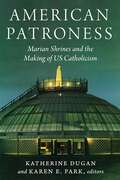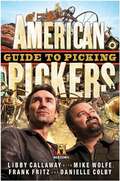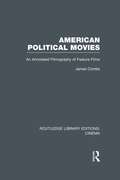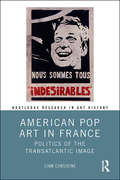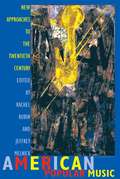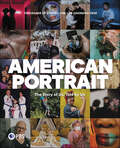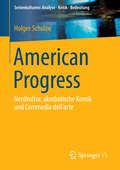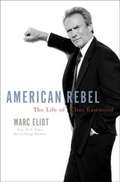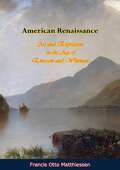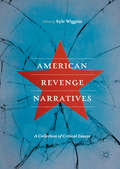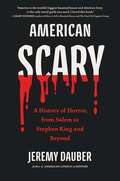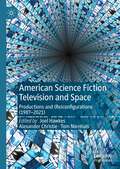- Table View
- List View
American Lightning: Terror, Mystery, and the Birth of Hollywood
by Howard BlumIt was an explosion that reverberated across the country--and into the very heart of early-twentieth-century America. On the morning of October 1, 1910, the walls of the Los Angeles Times Building buckled as a thunderous detonation sent men, machinery, and mortar rocketing into the night air. When at last the wreckage had been sifted and the hospital triage units consulted, twenty-one people were declared dead and dozens more injured. But as it turned out, this was just a prelude to the devastation that was to come. In American Lightning, acclaimed author Howard Blum masterfully evokes the incredible circumstances that led to the original "crime of the century"--and an aftermath more dramatic than even the crime itself. With smoke still wafting up from the charred ruins, the city's mayor reacts with undisguised excitement when he learns of the arrival, only that morning, of America's greatest detective, William J. Burns, a former Secret Service man who has been likened to Sherlock Holmes. Surely Burns, already world famous for cracking unsolvable crimes and for his elaborate disguises, can run the perpetrators to ground. Through the work of many months, snowbound stakeouts, and brilliant forensic sleuthing, the great investigator finally identifies the men he believes are responsible for so much destruction. Stunningly, Burns accuses the men--labor activists with an apparent grudge against the Los Angeles Times' fiercely anti-union owner--of not just one heinous deed but of being part of a terror wave involving hundreds of bombings. While preparation is laid for America's highest profile trial ever--and the forces of labor and capital wage hand-to-hand combat in the streets--two other notable figures are swept into the drama: industry-shaping Filmmaker D. W. Griffith, who perceives in these events the possibility of great art and who will go on to alchemize his observations into the landmark film The Birth of a Nation; and crusading lawyer Clarence Darrow, committed to lend his eloquence to the defendants, though he will be driven to thoughts of suicide before events have fully played out. Simultaneously offering the absorbing reading experience of a can't-put-it-down thriller and the perception-altering resonance of a story whose reverberations continue even today, American Lightning is a masterpiece of narrative nonfiction.
American Locomotives in Historic Photographs: 1858 to 1949
by Ron ZielThis rare collection of 126 "builder portraits" of American locomotives offers an exciting cavalcade of images that chronicle the momentous rise of steam locomotive power in America. Builder portraits are especially prized by railway historians because they are the exacting official photographs of new models taken before repairs, alterations, and weathering altered their original appearance. The builder portraits reprinted here were selected from the William A. Rogers collection, a priceless archive of images documenting the history of American steam locomotion from the pre-Civil War era to the mid-20th century. While the accent in this book is on the oldest and rarest photographs in the Rogers collection, many modern portraits are included as well to demonstrate how highly developed the American steam locomotive had become before the advent of dieselization. Among the engines depicted are the España, a diminutive model built for the Spanish government in 1858; engine no. 216 of the Pennsylvania Railroad, a "fearsome apparition of Gothic character" built in 1861; the Chimbote Emilia, an inspection engine built for railroad company officials in 1868 that is considered a masterpiece of the engine builder's art; and a Union Pacific 1940s' "Big Boy," the largest and heaviest type of steam locomotive ever built.Clearly, builder portraits are the most revealing record possible of the evolution of the American steam locomotive. This rich selection offers railroading historians and enthusiasts a peerless record of a great age in railway history. Railroading expert Ron Zeil's introduction and captions provide readers with a brief railroading background, a commentary on the art of the builder portrait and key details on each locomotive depicted.
American Masculinities in Contemporary Documentary Film: Up Close Behind the Mask (Routledge Advances in Film Studies)
by Sara MartínMost documentaries deal with men, but what do they actually say about masculinity? In this groundbreaking volume Sara Martín analyses more than forty 21st-century documentaries to explore how they represent American men and masculinity. From Jennifer Siebel Newsom’s The Mask You Live In to Raoul Peck’s I Am Not Your Negro, this volume explores sixteen different faces of American masculinity: the good man, the activist, the politician, the whistleblower, the criminal, the sexual abuser, the wrongly accused, the dependent man, the soldier, the capitalist, the adventurer, the sportsman, the architect, the photographer, the musician, and the writer. The collective portrait drawn by the documentaries discloses a firm critical stance against the contradictions inherent in patriarchy, which makes American men promises of empowerment it cannot fulfill. The filmmakers’ view of American masculinity emphasizes the vulnerability of disempowered men before the abuses of the patriarchal system run by hegemonic men and a loss of bearings about how to be a man after the impact of feminism, accompanied nonetheless by a celebration of resilient masculinity and of the good American man. Firmly positioning documentaries as an immensely flexible, relevant tool to understand 21st-century American men and masculinity, their past, present, and future, this book will interest students and scholars of film studies, documentary film, American cultural studies, gender, and masculinity.
American Media and the Memory of World War II (Routledge Research in Cultural and Media Studies)
by Debra RamsayFor three generations of Americans, World War II has been a touchstone for the understanding of conflict and of America’s role in global affairs. But if World War II helped shape the perception of war for Americans, American media in turn shape the understanding and memory of World War II. Concentrating on key popular films, television series, and digital games from the last two decades, this book explores the critical influence World War II continues to exert on a generation of Americans born over thirty years after the conflict ended. It explains how the war was configured in the media of the wartime generation and how it came to be repurposed by their progeny, the Baby Boomers. In doing so, it identifies the framework underpinning the mediation of World War II memory in the current generation’s media and develops a model that provides insight into the strategies of representation that shape the American perspective of war in general.
American Militarism on the Small Screen (Routledge Advances in Television Studies)
by Anna Froula Stacy TakacsAnna Froula is Associate Professor of Film Studies in the Department of English at East Carolina University, USA Stacy Takacs is Associate Professor and Director of American Studies at Oklahoma State University, USA
American Military Shoulder Arms, Volume I: Colonial and Revolutionary War Arms
by George D. MollerAmerican Military Shoulder Arms, Volume I: Colonial and Revolutionary War Arms focuses on the arms used from the early exploratory period throughout the colonial period and the American Revolution. Arranged chronologically, it contains definitive descriptions of the pre-flintlock and flintlock shoulder arms used in North America and detailed accounts of the development and progression of military regulation shoulder arms of the major colonial powers from the early eighteenth century through the Revolutionary War. Lavishly illustrated with more than four hundred vivid photographs of muskets, rifles, carbines, and other arms, this book offers an intelligent analysis of the shoulder arms procured and used by the colonists, colonial and state governments, and the Continental Congress.
American Military Shoulder Arms, Volume II: From the 1790s to the End of the Flintlock Period
by George D. MollerNew data surrounding the procurement and modifications of arms produced by the national armories, and under federal contract procured by the individual states and by individual members of militias, is presented here for the first time. This information, interwoven with military, political, economic, and social factors, results in new and better definitions and a clearer understanding of the arms&’ historical context. Though this work focuses on military flintlock shoulder arms, details on the federal government&’s procurement of arms for Indians during rapidly changing military policies of the period is also included. American Military Shoulder Arms, Volume II, contains more than three hundred photographs. As with the previous volume, Volume II is written primarily for students of arms, but also contains material of interest to historians, museum specialists, collectors, and dealers of antique arms.
American Military Shoulder Arms, Volume III: Flintlock Alterations and Muzzleloading Percussion Shoulder Arms, 1840-1865
by George D. MollerThis third volume in Moller&’s authoritative reference work describes muzzleloading percussion shoulder arms procured by the U.S. government for issue to federal and state armed forces in the period that includes the Civil War. These twenty-five years were an exciting time in the history of shoulder arms. During the 1840s, only a handful of American manufacturers were capable of producing significant quantities of arms having fully interchangeable components. By the early 1850s, at least one firm was producing rifles with close enough tolerances to be considered fully interchangeable. And thanks to the invention of the expanding bullet, rifled arms could be used by an army&’s entire infantry. For the first time, line infantry were equipped with arms capable of rapid reloading and of consistently hitting a man-sized target at distances as great as three hundred yards. Like the first two volumes of American Military Shoulder Arms, this exhaustive reference work will be a must for serious arms collectors, dealers, and museum specialists.
American Mirror: The Life and Art of Norman Rockwell
by Deborah SolomonA NEW YORK TIMES BOOK REVIEW NOTABLE BOOK OF THE YEAR A FINALIST FOR THE LOS ANGELES TIMES BOOK PRIZE IN BIOGRAPHY AND SHORTLISTED FOR THE PEN/JACQUELINE BOGRAD WELD AWARD FOR BIOGRAPHY"Welcome to Rockwell Land," writes Deborah Solomon in the introduction to this spirited and authoritative biography of the painter who provided twentieth-century America with a defining image of itself. As the star illustrator of The Saturday Evening Post for nearly half a century, Norman Rockwell mingled fact and fiction in paintings that reflected the we-the-people, communitarian ideals of American democracy. Freckled Boy Scouts and their mutts, sprightly grandmothers, a young man standing up to speak at a town hall meeting, a little black girl named Ruby Bridges walking into an all-white school—here was an America whose citizens seemed to believe in equality and gladness for all.Who was this man who served as our unofficial "artist in chief" and bolstered our country's national identity? Behind the folksy, pipe-smoking façade lay a surprisingly complex figure—a lonely painter who suffered from depression and was consumed by a sense of inadequacy. He wound up in treatment with the celebrated psychoanalyst Erik Erikson. In fact, Rockwell moved to Stockbridge, Massachusetts so that he and his wife could be near Austen Riggs, a leading psychiatric hospital. "What's interesting is how Rockwell's personal desire for inclusion and normalcy spoke to the national desire for inclusion and normalcy," writes Solomon. "His work mirrors his own temperament—his sense of humor, his fear of depths—and struck Americans as a truer version of themselves than the sallow, solemn, hard-bitten Puritans they knew from eighteenth-century portraits."Deborah Solomon, a biographer and art critic, draws on a wealth of unpublished letters and documents to explore the relationship between Rockwell's despairing personality and his genius for reflecting America's brightest hopes. "The thrill of his work," she writes, "is that he was able to use a commercial form [that of magazine illustration] to thrash out his private obsessions." In American Mirror, Solomon trains her perceptive eye not only on Rockwell and his art but on the development of visual journalism as it evolved from illustration in the 1920s to photography in the 1930s to television in the 1950s. She offers vivid cameos of the many famous Americans whom Rockwell counted as friends, including President Dwight Eisenhower, the folk artist Grandma Moses, the rock musician Al Kooper, and the generation of now-forgotten painters who ushered in the Golden Age of illustration, especially J. C. Leyendecker, the reclusive legend who created the Arrow Collar Man.Although derided by critics in his lifetime as a mere illustrator whose work could not compete with that of the Abstract Expressionists and other modern art movements, Rockwell has since attracted a passionate following in the art world. His faith in the power of storytelling puts his work in sync with the current art scene. American Mirror brilliantly explains why he deserves to be remembered as an American master of the first rank.
American Missiles: The Complete Smithsonian Field Guide
by Brian D. NicklasThis remarkable guide provides for the first time an illustrated listing of almost 200 of Americas most powerful missiles. With information on all aspects of the missiles specifications, including the speed and capacity of the explosives used in its warhead, this book provides a comprehensive guide to the US Armys projectile hardware. 'American Missiles: The Complete Smithsonian Field Guide' draws heavily on the Herbert S. Desind Photo Collection, a resource of more than 110,000 images recently catalogued at the National Air and Space Museum. Of interest to both the specialist and the aviation enthusiasts, this book demonstrates the evolution of American missile design over the last forty years in an accessible and entertaining format.
American Modern
by Thomas Obrien“One of those designers whose interior and furniture designs look discovered, not created . . . both comfortable and exquisite, calm and eclectic.” —Apartment TherapyDesigner and merchant, collector and tastemaker, Thomas O’Brien has made a career of translating cool notions of modernism into an easy and generous array of modern styles that anyone can attain. Now he introduces readers to a range of those styles—from casual to formal, vintage to urban—alongside stunning photography and charming design stories.O’Brien carefully describes the design process of his chosen projects, including a downtown New York City loft, a traditional Connecticut estate, and a converted schoolhouse in eastern Long Island. Each home explores a view on the modern design spectrum he has created, as well as the individual choices that make the design unique and its mix essentially American. He explains not only what was at work to create a given style, but how readers can import those practices to their own homes and personal design sensibilities. Important design principles such as architectural authenticity, color relationships, correctness of scale, and informed collecting are threaded through a practical narrative that reads like a master class in interior design. American Modern is an inspiring design volume that will redefine the way readers think about modern interiors.“O’Brien carefully describes the design process of his chosen projects. Beautiful imagery and a unique layout describe his approach to design in a new and innovative way.” —LIFEMSTYLE“It’s like getting a glimpse into the studio paintings of a great master . . . I especially love how all of his spaces feel so gender neutral, the perfect balance.” —Cottage Farm
American Musical Theatre
by Steven PorterFirst Published in 1987. Split into four parts, this book seeks to inform the reader, teachers, directors and students about American Musical Theatre. Part I is a brief history of the American Musical Theatre, for it is only in the context of history that the material on which you work can be fully judged and mastered. Part II is a brief discussion of the elements of production. Knowing what ought to take place in a well-planned show can go a long way toward counteracting what does not take place in a poorly planned one. Part III is a brief discussion of how to evaluate the elements of craftmanship one expects to find in the writing and performing of a musical. The knowledge here is indispensable to the performer. It is the feel of the plane to the pilot, the touch of the key to the pianist. It is, in fact, the very life blood of the art form. Finally, Part IV provides an opportunity to put into practice what previous study has taught.
American Myths in Post-9/11 Music
by Daniele CuffaroAfter September 11, 2001, the void left following the attack on the Twin Towers in the heart of New York was the visible symbol that there was to be a breaking point with the past. The attacks dramatically changed the everyday lives of the American people and the new devastating landscape led people to seek to restore the certainties that had been so suddenly shattered. In doing this, Americans went back to the historical myths in their culture. This book explores the collective memory and historical American myths like, for example, the myth of the innocent nation and the frontier myth, and shows how some of these nationally considered historical truths have not disappeared, but were indeed exhumed in the music produced post-9/11.
American Patroness: Marian Shrines and the Making of US Catholicism (Catholic Practice in the Americas)
by Katherine Dugan and Karen E. ParkA vital collection of interdisciplinary essays that illuminates the significance of Marian shrines and promises to teach scholars how to “read” them for decades to come.American Patroness: Marian Shrines and the Making of US Catholicism is a collection of twelve essays that examine the historical and contemporary roles of Marian shrines in US Catholicism. The essays in this collection use historical, ethnographic, and comparative methods to explore how Catholics have used Marian devotion to make an imprint on the physical and religious landscape of the United States. Using the dynamic malleability of Marian shrines as a starting place for studying US Catholicism, each chapter reconsiders the American religious landscape from the perspective of a single shrine to Mary and asks: What does this shrine reveal about US Catholicism and about American religion?Each of the contributors in American Patroness examines why and how Marian shrines persist in the twenty-first century and subsequently uses that examination to re-read contemporary US Catholicism. Because shrines are not neutral spaces—they reflect and shape the elastic yet strict boundaries of what counts as Catholic identity, and who controls prayer practices—the studies in this collection also shed light on the contested dynamics of these holy sites. American Patroness demonstrates that Marian shrines continue to be places where an American Catholic identity is continuously worked on, negotiations about power occur, and Marian relationships are fostered and nurtured in spaces that are simultaneously public and intimate.
American Pickers Guide to Picking
by Libby CallawayA true adventure story and the go-to guide for "picking" American treasures from anyone's backyard, straight from the stars of History's American PickersIn these pages, professional treasure hunters Mike Wolfe and Frank Fritz chronicle their road trips across the American countryside in search of "rusty gold" to buy and sell among the picking world's one-of-a-kind characters. Whether you are a fan of the show or just like finding hidden riches, you will love seeing what Wolfe and Fritz dig up and enjoy meeting the devoted collectors, extreme stockpilers, and elite dealers who they encounter along the way.Wolfe and Fritz do not deal in fine antiques. Their secondhand treasures are of the down-and-dirty and sometimes even bizarre variety, from old bicycles and vintage tools, to sun-bleached cars and handmade furniture, retired carnival games and unusual taxidermy. Assisted by Danielle Colby, who helps out at Antique Archaeology, Wolfe and Fritz buy on the cheap and then sell to dealers, art directors, interior designers, or anyone looking for a little bit of authentic Americana. The three now share their secrets to finding hidden gems, offering helpful hints that will show what average Americans can do to find the treasures that await them.From American Pickers Guide to Picking:Junk is BeautifulWhen we knock on a door, 90 percent of the time the things we find are junk. But we don't care about the odds; a picker never turns down an opportunity, no matter where it is. We've picked pickup trucks. We've picked flat beds. We've picked dumpsters. We even picked a Mercury Sable. We're looking for the unusual, the impossible, the funky, the different, the bizarre-things we have never seen before. And we'll go anywhere we have to go to find it.No location is off-limits to a hard-core picker. And there's plenty of things to be found at antique stores, thrift and consignment shops, flea markets, estate sales, and swap meets, and a lot of the tips in this book apply to finding treasures at these joints. But that's not really the kind of picking we do anymore. We look outside the box to find our junk-a word we use almost like a term of endearment: to us: junk is beautiful.
American Political Movies: An Annotated Filmography of Feature Films (Routledge Library Editions: Cinema)
by James CombsEssays here explore the relationship between politics and explicitly political feature films from the beginning of the movie industry to World War I, and for each decade through to the 1980's. The included filmography is particularly useful. Originally published in 1990, the method of inquiry put forward in this text is nonetheless extendable to the decades following its publication.
American Pop Art in France: Politics of the Transatlantic Image (Routledge Research in Art History)
by Liam ConsidinePop art was essential to the Americanization of global art in the 1960s, yet it engendered resistance and adaptation abroad in equal measure, especially in Paris. From the end of the Algerian War of Independence and the opening of Ileana Sonnabend’s gallery for American Pop art in Paris in 1962, to the silkscreen poster workshops of May ’68, this book examines critical adaptations of Pop motifs and pictorial devices across French painting, graphic design, cinema and protest aesthetics. Liam Considine argues that the transatlantic dispersion of Pop art gave rise to a new politics of the image that challenged Americanization and prefigured the critiques and contradictions of May ’68.
American Popular Music: New Approaches to the Twentieth Century
by Jeffrey Melnick Rachel RubinDesigned as a broad introductory survey, and written by experts in the field, this book examines the rise of American music over the 20th century - the period in which that music came into its own and achieved unprecedented popularity. Beginning with a look at music as a business, 11 essays explore a variety of popular musical genres, including Tin Pan Alley, blues, jazz, country, gospel, rhythm and blues, rock and roll, folk, rap, and Mexican American corridos. Reading these essays, we come to see that the forms created by one group often appeal to, and are in turn influenced by, other groups - across lines of race, ethnicity, class, gender, region and age. The chapters speak to one another, arguing for the primacy of such concepts as minstrelry, urbanization, hybridity and crossover as the most powerful tools for understanding American popular music. Moving beyond outdated music-industry categories and misleading genre labels, while acknowledging the complexities of the market, the book recovers and reinforces the essential blackness of much popular music - even a presumably white form like country and western.
American Portrait: The Story of Us, Told by Us
by PBSBased on the popular and revolutionary PBS multiplatform documentary project, an inspiring and striking photographic portrait that brilliantly captures the tumultuous, historic year that was 2020, offering an intimate look at the heart and soul of our national life and what it means to be an American today, revealed through the stories of ordinary people from sea to shining sea.Everyone has a story . . . In January 2020, in celebration of its 50th anniversary, PBS launched an ambitious national storytelling project, American Portrait, inviting people across the country to participate in a national conversation about what it means to be an American today. The multiplatform experience, including a television series that will air on PBS stations nationwide in January 2021, has created a communal voice through the individual stories of participants—each one a unique stitch in the beautiful, diverse quilt that is America. A vivid yet nuanced snapshot of who we are, this visually striking companion volume features more than 400 entries and photographs, all which began with an answer to a simple cue: My American story started when . . .You don’t know what it’s like to . . .My greatest challenge is . . . The tradition I carry on is . . . I was raised to believe . . . What keeps me up at night is . . .I took a risk when . . .When I step outside my door . . . Most days I feel . . . Told by people of all ages, orientations, and walks of life, these unique stories of joy, adversity, love, sacrifice, grief, sharing, triumph, and grace, centered on the themes of family, work, fun, faith, and community, illuminate the struggles, hopes, dreams, and convictions of Americans today. The more we share with our fellow citizens, the more we can see a real, complex, and fascinating representation of our country that is far richer and deeper than headlines and elections tell us. As intriguing, thoughtful, and distinct as the nation it embodies, American Portrait is a photographic manifestation of Walt Whitman’s immortal words, “I am large. I contain multitudes”—and a vital and ultimately hopeful reminder that what we all share is much greater and enduring than what may divide us.
American Progress: Nerdkultur, akrobatische Komik und Commedia dell'arte (Serienkulturen: Analyse – Kritik – Bedeutung)
by Holger SchulzeDie Serie 30Rock wälzt die medialen Erzählungen ihrer Epoche (und der Serie selbst) unaufhörlich um: in bislang sieben Staffeln, 140 Episoden, von 30 Autoren für 14 SchauspielerInnen geschrieben - rund um die Erfinderin und Hauptdarstellerin Tina Fey. Dieser Band untersucht die überdrehte Gegenwartsdystopie, ihre Erzählungen, Bühnen und Personen. Markante Episoden werden im Zusammenhang zeitgenössischer Pop- und TV-Kultur untersucht und einzelne ProtagonistInnen in ihrem medialen Handeln und dessen Referenzen. Ein Tableau der Medien- und der Nerdkultur sowie der politischen Agitation entsteht in Form von akrobatischer Komik und Celebrityobsession: eine Form der Commedia dell'arte über den American Progress.
American Rebel: The Life of Clint Eastwood
by Marc EliotAs an actor, he seduces us with his tough-guy charm. As a director and producer, he amazes us with his artistry and technical savvy. As a Hollywood icon, Clint Eastwood, one of film's greatest living legends, represents some of the finest cinematic achievements in the history of American cinema. In American Rebel, bestselling author and acclaimed film historian Marc Eliot examines the ever-exciting, often-tumultuous arc of Clint Eastwood's life and career. Unlike past biographers, Eliot writes with unflinching candor about Eastwood's highs and lows, his artistic successes and failures, and the fascinating, complex relationship between his life and his craft. Eliot's prodigious research reveals how a college dropout and unambitious playboy rose to fame as Hollywood' s "sexy rebel," eventually and against all odds becoming a star in the Academy pantheon as a multiple Oscar winner. Spanning decades, American Rebel covers the best of Eastwood' s oeuvre, films that have fast become American classics–Fistful of Dollars, Dirty Harry, Unforgiven, Mystic River, Million Dollar Baby, and Gran Torino. Filled with remarkable insights into Eastwood's personal life and public work, American Rebel is highly entertaining and the most complete biography of one of Hollywood's truly respected and beloved stars–an actor who, despite being the Man with No Name, has left his indelible mark on the world of motion pictures.From the Hardcover edition.
American Renaissance: Art and Expression in the Age of Emerson and Whitman
by Francis Otto MatthiessenThis text has taken its place as the definitive treatment of the most distinguished age of American literature. Centering the discussion around five literary giants of the mid-nineteenth century—Emerson, Thoreau, Hawthorne, Melville, and Whitman. Matthiessen elucidates their conceptions of the nature and function of literature, and the extent to which these were realized in their writings.
American Revenge Narratives: A Collection of Critical Essays
by Kyle WigginsAmerican Revenge Narratives critically examines the nation’s vengeful storytelling tradition. With essays on late twentieth and twenty-first century fiction, film, and television, it maps the coordinates of the revenge genre’s contemporary reinvention across American culture. By surveying American revenge narratives, this book measures how contemporary payback plots appraise the nation’s political, social, and economic inequities. The volume’s essays collectively make the case that retribution is a defining theme of post-war American culture and an artistic vehicle for critique. In another sense, this book presents a scholarly coming to terms with the nation’s love for vengeance. By investigating recent iterations of an ancient genre, contributors explore how the revenge narrative evolves and thrives within American literary and filmic imagination. Taken together, the book’s diverse chapters attempt to understand American culture’s seemingly inexhaustible production of vengeful tales.
American Scary: A History of Horror, from Salem to Stephen King and Beyond
by Jeremy Dauber"America is the world's biggest haunted house and American Scary is the only travel guide you need. I loved this book." —Grady Hendrix, New York Times bestselling author of How to Sell a Haunted House and The Final Girl Support GroupFrom the acclaimed author of American Comics comes a sweeping and entertaining narrative that details the rise and enduring grip of horror in American literature, and, ultimately, culture—from the taut, terrifying stories of Edgar Allan Poe to the grisly, lingering films of Jordan Peele America is held captive by horror stories. They flicker on the screen of a darkened movie theater and are shared around the campfire. They blare out in tabloid true-crime headlines, and in the worried voices of local news anchors. They are consumed, virally, on the phones in our pockets. Like the victims in any slasher movie worth its salt, we can&’t escape the thrall of scary stories. In American Scary, noted cultural historian and Columbia professor Jeremy Dauber takes the reader to the startling origins of horror in the United States. Dauber draws a captivating through line that ties historical influences ranging from the Salem witch trials and enslaved-person narratives directly to the body of work we more closely associate with horror today: the weird tales of H. P. Lovecraft, the lingering fiction of Shirley Jackson, the disquieting films of Alfred Hitchcock, the up-all-night stories of Stephen King, and the gripping critiques of Jordan Peele. With the dexterous weave of insight and style that have made him one of America&’s leading historians of popular culture, Dauber makes the haunting case that horror reveals the true depths of the American mind.
American Science Fiction Television and Space: Productions and (Re)configurations (1987-2021)
by Joel Hawkes Alex Christie Tom NienhuisThis collection reads the science fiction genre and television medium as examples of heterotopia (and television as science fiction technology), in which forms, processes, and productions of space and time collide – a multiplicity of spaces produced and (re)configured. The book looks to be a heterotopic production, with different chapters and “spaces” (of genre, production, mediums, technologies, homes, bodies, etc), reflecting, refracting, and colliding to offer insight into spatial relationships and the implications of these spaces for a society that increasingly inhabits the world through the space of the screen. A focus on American science fiction offers further spatial focus for this study – a question of geographical and cultural borders and influence not only in terms of American science fiction but American television and streaming services. The (contested) hegemonic nature of American science fiction television will be discussed alongside a nation that has significantly been understood, even produced, through the television screen. Essays will examine the various (re)configurations, or productions, of space as they collapse into the science fiction heterotopia of television since 1987, the year Star Trek: Next Generation began airing.
